Here is our list of the most essential scuba gear. This list will help you figure out what you need to start diving. Every diver’s personal preferences differ, which leads to each diver having varying equipment, but most divers recommend the following gear. Scuba gear needed will also vary based on the environment in which you are diving.
Scuba Mask
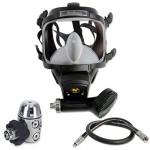 The scuba mask is one of the most important pieces of scuba gear. Without it, a diver would not be able to see underwater. The scuba mask also helps equalize pressure on ears and sinuses. It is important to find a scuba mask that fits well, because any excess space can cause leakage and fogging, and getting a mask that is too small can cause an uncomfortable amount of pressure to be exerted on your face. It is crucial to have a scuba mask that features tempered glass or durable composite materials so your lenses do not crack or break. Many divers carry an extra scuba mask in case of loss or damage. A diving mask is one piece of scuba gear you don’t want to be caught without.
The scuba mask is one of the most important pieces of scuba gear. Without it, a diver would not be able to see underwater. The scuba mask also helps equalize pressure on ears and sinuses. It is important to find a scuba mask that fits well, because any excess space can cause leakage and fogging, and getting a mask that is too small can cause an uncomfortable amount of pressure to be exerted on your face. It is crucial to have a scuba mask that features tempered glass or durable composite materials so your lenses do not crack or break. Many divers carry an extra scuba mask in case of loss or damage. A diving mask is one piece of scuba gear you don’t want to be caught without.
Scuba Fins
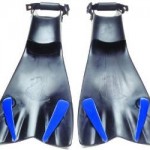 Scuba fins are another one of the most vital pieces of scuba gear. You’re not going to go far without a pair of these! Scuba fins help a diver maintain a high level of maneuverability in the water. They also help divers conserve energy by decreased the level of exertion required for swimming. Stay underwater longer by conserving your energy. There are many different types of scuba fins, but it’s important to have scuba fins that fit snugly to ensure they do not slip off while diving. Make sure you have a pair of scuba fins in your scuba gear bag!
Scuba fins are another one of the most vital pieces of scuba gear. You’re not going to go far without a pair of these! Scuba fins help a diver maintain a high level of maneuverability in the water. They also help divers conserve energy by decreased the level of exertion required for swimming. Stay underwater longer by conserving your energy. There are many different types of scuba fins, but it’s important to have scuba fins that fit snugly to ensure they do not slip off while diving. Make sure you have a pair of scuba fins in your scuba gear bag!
Scuba Tank
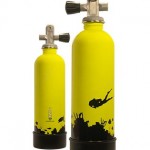 The scuba tank is arguable the most essential piece of scuba gear. Without it, divers would not be able to take a supply of diving gas with them to the depths. Tanks are usually small, metal cylinders designed to withstand high pressure and hold large amounts of compressed gas for diving. Most commonly, scuba tanks are filled with a diving gas that is a mixture of about 21% oxygen and 79% nitrogen. Technically, 1% of the nitrogen is actually minute amounts of other gases, but those gases are usually classified as nitrogen. This mixture has a safe depth limit of about 130 feet. Other diving with different proportions of oxygen and other gases can extend the depth limit. Without a doubt, a high-quality scuba tank is a critical piece of scuba gear for ensuring a safe dive.
The scuba tank is arguable the most essential piece of scuba gear. Without it, divers would not be able to take a supply of diving gas with them to the depths. Tanks are usually small, metal cylinders designed to withstand high pressure and hold large amounts of compressed gas for diving. Most commonly, scuba tanks are filled with a diving gas that is a mixture of about 21% oxygen and 79% nitrogen. Technically, 1% of the nitrogen is actually minute amounts of other gases, but those gases are usually classified as nitrogen. This mixture has a safe depth limit of about 130 feet. Other diving with different proportions of oxygen and other gases can extend the depth limit. Without a doubt, a high-quality scuba tank is a critical piece of scuba gear for ensuring a safe dive.
Snorkel
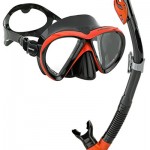 They aren’t much use in the deep, but a snorkel is still a significant piece of scuba gear. Snorkels are used to help you breath while in shallow water or on the surface. A snorkel essentially a tube that extends above the water with an mouthpiece for breathing. A snorkel can help you conserve energy while on the surface and can help you assess what is below before diving. A snorkel should have a comfortable mouthpiece that fits snugly in your mouth, and should also feature a way to attach the snorkel to your mask. There are many models of snorkels to choose from, but regardless, every diver should have a snorkel on their equipment checklist!
They aren’t much use in the deep, but a snorkel is still a significant piece of scuba gear. Snorkels are used to help you breath while in shallow water or on the surface. A snorkel essentially a tube that extends above the water with an mouthpiece for breathing. A snorkel can help you conserve energy while on the surface and can help you assess what is below before diving. A snorkel should have a comfortable mouthpiece that fits snugly in your mouth, and should also feature a way to attach the snorkel to your mask. There are many models of snorkels to choose from, but regardless, every diver should have a snorkel on their equipment checklist!
Wetsuit or Drysuit
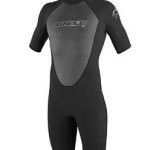 A wetsuit is a pieces of scuba gear that is at the top of every diver’s equipment list. In fact, the picture most people have of divers would not be complete without a wetsuit or drysuit. Wetsuits and drysuits are often called exposure protection. Why? The reason is simple: they protect a diver from being exposed to the cooling effects of the water around them in addition to shielding them from any abrasive or sharp objects they may encounter. Wetsuits, aptly named, still allow a diver to get wet while wearing them. They work by warming only the thin layer of water contained in the suit surrounding the diver’s body. Drysuits, also aptly named, keep a diver from getting wet. The drysuit works by creating a watertight seal at important areas, including at the neck, wrist, and ankles. No matter what method of exposure protection you choose for your diving adventure, make sure you have a wetsuit or drysuit in your gear bag!
A wetsuit is a pieces of scuba gear that is at the top of every diver’s equipment list. In fact, the picture most people have of divers would not be complete without a wetsuit or drysuit. Wetsuits and drysuits are often called exposure protection. Why? The reason is simple: they protect a diver from being exposed to the cooling effects of the water around them in addition to shielding them from any abrasive or sharp objects they may encounter. Wetsuits, aptly named, still allow a diver to get wet while wearing them. They work by warming only the thin layer of water contained in the suit surrounding the diver’s body. Drysuits, also aptly named, keep a diver from getting wet. The drysuit works by creating a watertight seal at important areas, including at the neck, wrist, and ankles. No matter what method of exposure protection you choose for your diving adventure, make sure you have a wetsuit or drysuit in your gear bag!
Buoyancy Control Device / Buoyancy Compensator
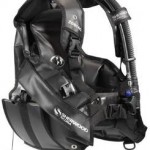 A buoyancy compensator (BC) or buoyancy control device (BCD) helps a diver adjust their buoyancy as needed. This piece of scuba equipment helps a diver achieve neutral buoyancy underwater and positive buoyancy on the surface. Many divers choose not to purchase this piece of scuba gear because they can be difficult to transport and expensive. Instead, those divers will rent a buoyancy compensator at each individual dive location. However, divers often prefer owning their own set of scuba gear. This allows the diver to personalize their diver equipment, and also allows them to tailor their scuba equipment to their specific wants and needs. There are many different types of buoyancy control devices, but the most important factor in determining which is right for you is the fit. Make sure your BCD is snug, but not too tight. BCDs that are not precisely fitted will not perform their intended function properly. A BCD is not a piece of scuba gear that you need to own, but nonetheless, they are essential for a safe and enjoyable dive!
A buoyancy compensator (BC) or buoyancy control device (BCD) helps a diver adjust their buoyancy as needed. This piece of scuba equipment helps a diver achieve neutral buoyancy underwater and positive buoyancy on the surface. Many divers choose not to purchase this piece of scuba gear because they can be difficult to transport and expensive. Instead, those divers will rent a buoyancy compensator at each individual dive location. However, divers often prefer owning their own set of scuba gear. This allows the diver to personalize their diver equipment, and also allows them to tailor their scuba equipment to their specific wants and needs. There are many different types of buoyancy control devices, but the most important factor in determining which is right for you is the fit. Make sure your BCD is snug, but not too tight. BCDs that are not precisely fitted will not perform their intended function properly. A BCD is not a piece of scuba gear that you need to own, but nonetheless, they are essential for a safe and enjoyable dive!
Scuba Regulator & Octopus
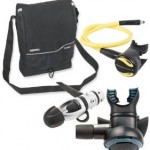 The regulator and octopus are essential pieces of scuba gear because they allow divers to breathe underwater. The regulator attaches to the diver’s scuba tank, and delivers the air from the tank to the diver’s mouth, allowing them to breathe. The octopus is an alternate air source, used for backup and emergencies. It is usually a bright color which allows divers, and those diving with them, to find the octopus in case of emergency. The key to choosing the best scuba regulator for you is to match the specifications of the regulator to the conditions you will be diving in. It is also important to make sure your regulator will work with your scuba tank and other pieces of scuba gear. No matter the regulator and octopus you choose, make sure you pack this piece of scuba equipment in your bag, or you won’t be diving at all!
The regulator and octopus are essential pieces of scuba gear because they allow divers to breathe underwater. The regulator attaches to the diver’s scuba tank, and delivers the air from the tank to the diver’s mouth, allowing them to breathe. The octopus is an alternate air source, used for backup and emergencies. It is usually a bright color which allows divers, and those diving with them, to find the octopus in case of emergency. The key to choosing the best scuba regulator for you is to match the specifications of the regulator to the conditions you will be diving in. It is also important to make sure your regulator will work with your scuba tank and other pieces of scuba gear. No matter the regulator and octopus you choose, make sure you pack this piece of scuba equipment in your bag, or you won’t be diving at all!
Depth Gauge
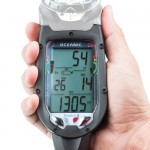 How do divers know how deep in the water they are? The answer is the depth gauge. Many divers opt out of using depth gauges and instead use the more modern diver computer. Depth gauges can still be an important piece of scuba gear that some divers will not dive without. Modern depth gauges have an electronic display, but regardless whether you choose an analogue or digital depth gauge, they work on the same principle. They measure the pressure being exerted on them by the surrounding water and display an equivalent depth. This helps divers understand how deep they are, as well as helping to prevent decompression sickness when diving. An important consideration when choosing a depth gauges is where you plan to use it. Some divers recommend purchasing two depth gauges because depth gauges that are used in both freshwater and saltwater will sometimes display inaccurate depth readings because of the natural differences in density of the two types of water.
How do divers know how deep in the water they are? The answer is the depth gauge. Many divers opt out of using depth gauges and instead use the more modern diver computer. Depth gauges can still be an important piece of scuba gear that some divers will not dive without. Modern depth gauges have an electronic display, but regardless whether you choose an analogue or digital depth gauge, they work on the same principle. They measure the pressure being exerted on them by the surrounding water and display an equivalent depth. This helps divers understand how deep they are, as well as helping to prevent decompression sickness when diving. An important consideration when choosing a depth gauges is where you plan to use it. Some divers recommend purchasing two depth gauges because depth gauges that are used in both freshwater and saltwater will sometimes display inaccurate depth readings because of the natural differences in density of the two types of water.
Submersible Pressure Gauge
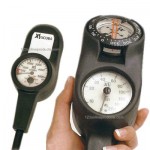 Submersible pressure gauges (SPGs) are used to monitor the gas pressure in the diver’s scuba tank. This helps a diver maintain a constant reading on how much gas is left in their cylinder. The submersible pressure gauge is another piece of equipment that is not necessary if a diver has a dive computer that interfaces with air tanks. Some divers will still attach a pressure gauge to their tank as a backup so they always have a reading on their air levels. Submersible pressure gauges are a relatively small piece of equipment, but their importance should not be overlooked. They are an essential piece of scuba gear to keep you safe during your dive!
Submersible pressure gauges (SPGs) are used to monitor the gas pressure in the diver’s scuba tank. This helps a diver maintain a constant reading on how much gas is left in their cylinder. The submersible pressure gauge is another piece of equipment that is not necessary if a diver has a dive computer that interfaces with air tanks. Some divers will still attach a pressure gauge to their tank as a backup so they always have a reading on their air levels. Submersible pressure gauges are a relatively small piece of equipment, but their importance should not be overlooked. They are an essential piece of scuba gear to keep you safe during your dive!
Dive Computer
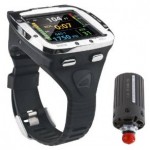 Dive computers are essential many different pieces of scuba gear combined into one modern device. Dive computers combine the functionality of a dive watch, dive tables (to calculate ascents), and some even incorporate the functionality of the submersible pressure gauge. Dive computers keep scuba divers up-to-date with real time information about their dive, including depth, current time, and even calculates the safest amount of time a diver can stay at depth. Most divers today use a dive computer instead of traditional devices because of the convenience and abundance of features they boast. A good dive computer will help take much of the guesswork out of diving. Dive computers are a crucial piece of scuba equipment that no diver should ever be without!
Dive computers are essential many different pieces of scuba gear combined into one modern device. Dive computers combine the functionality of a dive watch, dive tables (to calculate ascents), and some even incorporate the functionality of the submersible pressure gauge. Dive computers keep scuba divers up-to-date with real time information about their dive, including depth, current time, and even calculates the safest amount of time a diver can stay at depth. Most divers today use a dive computer instead of traditional devices because of the convenience and abundance of features they boast. A good dive computer will help take much of the guesswork out of diving. Dive computers are a crucial piece of scuba equipment that no diver should ever be without!
Dive Light
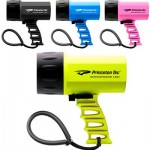 Some scuba divers might argue that dive lights are not an essential piece of scuba gear, but they are something no diver would want to be caught without. You never know when you might need to shed a little more light to do an underwater repair or check to make sure a crevice doesn’t contain something dangerous. The necessity of dive lights depends mostly on where you will be diving. The deeper you dive, the most essential lights become. Any diver planning on visiting underwater caves, deep locations, or diving at night should be equipped with dive lights. Dive lights can be large with bright, focused beams, or even small enough to fit in a pocket. Many divers always carry a small to medium-size dive light, about the size of a typical flashlight, with them so they are never without a light in case of an emergency. A dive light is a piece of scuba equipment you don’t want to be without when you need it.
Some scuba divers might argue that dive lights are not an essential piece of scuba gear, but they are something no diver would want to be caught without. You never know when you might need to shed a little more light to do an underwater repair or check to make sure a crevice doesn’t contain something dangerous. The necessity of dive lights depends mostly on where you will be diving. The deeper you dive, the most essential lights become. Any diver planning on visiting underwater caves, deep locations, or diving at night should be equipped with dive lights. Dive lights can be large with bright, focused beams, or even small enough to fit in a pocket. Many divers always carry a small to medium-size dive light, about the size of a typical flashlight, with them so they are never without a light in case of an emergency. A dive light is a piece of scuba equipment you don’t want to be without when you need it.
Dive Flag
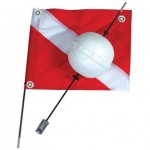 A dive flag is essential, and even required by law in many states and globally. Dive flags come in two forms: the red flag with a white diagonal stripe (primarily used in the U.S.) and the blue and white Alpha flag (the international flag). Both flags are intended to be signal to any other vessels on the water that there is a diver down and they should steer clear of the area. Flags can be flown from buoys or from a boat. Some U.S. states have specific rules and regulations for dive flags, requiring that they be a certain size and that vessels stay a certain distance away. Any company that takes you diving should have dive flags, but it is a good idea to have your own. If you ever plan on doing any dives on your own, they are a crucial piece of scuba gear and often required by law. A dive flag helps ensure you have a safe dive, so don’t be caught without one.
A dive flag is essential, and even required by law in many states and globally. Dive flags come in two forms: the red flag with a white diagonal stripe (primarily used in the U.S.) and the blue and white Alpha flag (the international flag). Both flags are intended to be signal to any other vessels on the water that there is a diver down and they should steer clear of the area. Flags can be flown from buoys or from a boat. Some U.S. states have specific rules and regulations for dive flags, requiring that they be a certain size and that vessels stay a certain distance away. Any company that takes you diving should have dive flags, but it is a good idea to have your own. If you ever plan on doing any dives on your own, they are a crucial piece of scuba gear and often required by law. A dive flag helps ensure you have a safe dive, so don’t be caught without one.
Dive Knife
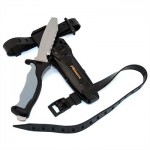 A dive knife is a simple tool, but it’s necessity can not be understated. Dive knives are essentially normal knives that have been specialized for diving. It is important to stress that dive knives are a tool, and not a weapon. They incorporate features like bright coloring, partially serrated blades, and many feature non-slip grips. Almost all divers carry a dive knife, although they might not use it on every dive. Dive knives are utilized for things like cutting rope and the butt of the handle can also be used as a makeshift hammer if need be.
A dive knife is a simple tool, but it’s necessity can not be understated. Dive knives are essentially normal knives that have been specialized for diving. It is important to stress that dive knives are a tool, and not a weapon. They incorporate features like bright coloring, partially serrated blades, and many feature non-slip grips. Almost all divers carry a dive knife, although they might not use it on every dive. Dive knives are utilized for things like cutting rope and the butt of the handle can also be used as a makeshift hammer if need be.
Scuba Gear Bag
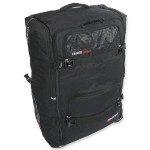 How do divers transport all of their scuba gear from dive site to dive site? Simple: they use a bag! Scuba gear bags are an extremely useful, and can help you easily transport your scuba equipment to each dive site. They are typically mesh bags which allow excess water to drain from your scuba equipment after a dive. However, scuba gear bags come in all shapes and sizes and can be constructed out of many different materials. The basic requirement for any scuba gear bag is simple, just like its function: make sure the bag fits all of your equipment and any diving accessories you need to bring along for your dive. Picking out a scuba gear bag is arguably the easiest part of equipping yourself to dive, but it is still an important step!
How do divers transport all of their scuba gear from dive site to dive site? Simple: they use a bag! Scuba gear bags are an extremely useful, and can help you easily transport your scuba equipment to each dive site. They are typically mesh bags which allow excess water to drain from your scuba equipment after a dive. However, scuba gear bags come in all shapes and sizes and can be constructed out of many different materials. The basic requirement for any scuba gear bag is simple, just like its function: make sure the bag fits all of your equipment and any diving accessories you need to bring along for your dive. Picking out a scuba gear bag is arguably the easiest part of equipping yourself to dive, but it is still an important step!
